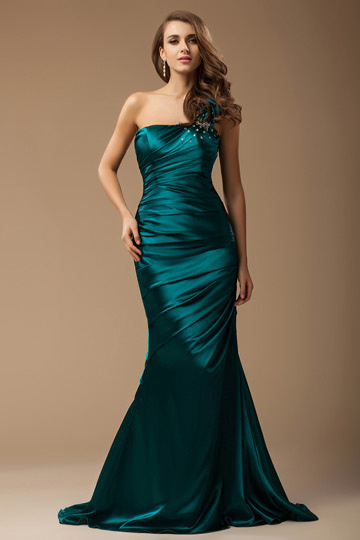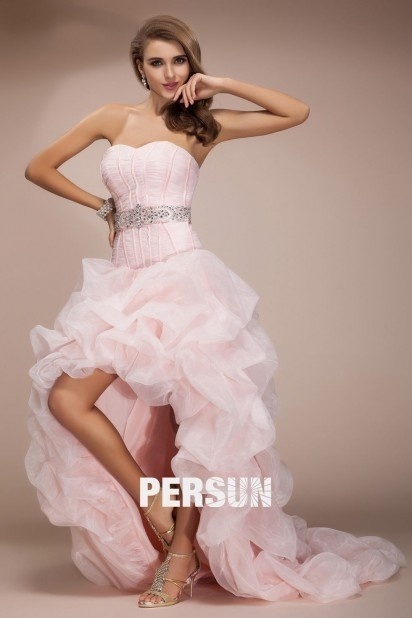Before the wedding, every woman longs to find a best evening gown to attend their parties. However, new evening dresses are often expensive. How to get your ideal evening gowns on a budget? If you have known some basic information about sewing, you will know how to sew your evening gowns from this article.
Is it possible to sew a evening wear in prive? In general,sewing evening dresses gives us an immediate visual of an haute couture atelier with well-known designers, artisans and tailors draping dress forms, elaborate fabrics and lace, beading and crystals. However, sewing an evening gown yourself can seem intimidating. Through learning basic draping techniques, you will be able to take your idea from sketch to pattern and construction. With a few simple guidelines and practice, you will be able to begin sewing formal evening dresses just like a professional.

Elegant evening dresses in green
What do you need to prepare?
1.Sewing evening gowns gives us an immediate visual of an haute couture atelier with well-known designers, artisans and tailors draping dress forms, elaborate fabrics and lace, beading and crystals. However, sewing an evening gown yourself can seem intimidating. By learning basic draping techniques, you will be able to take your idea from sketch to pattern and construction. With a few simple guidelines and practice, you will be able to begin sewing evening gowns just like a professional.
2.Sketch your initial concept. Although researching designer runway collections will inspire your sketching, the key factor for evening gowns is construction, silhouette, draping, fabric and trim selection. Visit your local designer boutiques, and take note of the draping and construction of several gowns. For example, a streamlined evening gown with a high front leg slit will require less draping than a draped bodice with a full bottom sweep. Try an evening gown on, and turn it inside out in order to view the inner construction such as bone work, seaming finishes, and novelty linings and trim application.
3.Select your fabric. Your choice will rely heavily on the type of gown you have designed and how much draping is involved. Hold the fabric by the highest point on the bias. You will be able to view the fabric's natural drape without pinning or draping on your dress form. For example, a silk crepe back satin, a silk four-ply woven crepe, a silk satin face organza or a silk faille, although higher in price, will offer you a different type drape than a silk chiffon, silk stretch charmeuse or a silk crepe de chine.

Pink evening dresses for young women
4.Select your trims. Check for any special looping for beads or novelty trim application. If you are adding a beaded applique or embroidery pattern, it is best to bead and embroider the pattern parts separately and cut your fabric pattern as a full pattern panel. If you are beading a specifically designed pattern on your fabric part, it is best to cut your fabric part separately and sew any necessary handwork, prior to machine sewing and constructing your gown.
5.Drape your gown on your dress form prior to cutting your pattern. Certain fabrics, such as silks or dutchess satins, will leave pinholes in your fabric. Test the selvage, and see your fabric's reaction to pins. Draping your gown will offer you the opportunity to alter your initial sketch and make necessary changes to necklines, back interest, slits, sleeves or contoured waistlines. Keep in mind that most of these fabrics do not have significant stretch properties and are challenging to alter once cut and hemmed. Leave sufficient seam allowance in the event you must alter the dress.
6.Draft your initial paper pattern. Make a sloper of your evening gown before cutting your fabric for construction. A sloper is a term used when sewing the dress completely in a sample fabric such as muslin. This fabric is relatively inexpensive, has draping properties and will offer you the opportunity to fit your gown and make paper pattern adjustments and changes to your gown without damaging your project fabric.

Grey evening dresses
How to operate it?
Above all,cut all your fabric parts. Carefully pin the parts together prior to stitching. Smooth textured and light fabrics, such as silks, satins, laces and velvet, have a tendency to roll. Fabric shifting during stitching will cause uneven seams. Cut your lining separate from your gown's shell.
Secondly,add your trims, beads or embroidery to your fabric parts. Do not attach your trims directly to your shell and lining. This will not give you smooth inner seams and appearance. It can also cause discomfort when wearing your gown.

The last step,sew your gown's shell and lining separately. Change your needle size, thread and sewing tension to accommodate your fabric type. Pin the two parts prior to stitching. Fit your gown to ensure your lining is no longer than your gown's shell. Check for any seam work bunching or puckering. You can opt to run a long machine or hand-basting stitch to secure your parts and then run your straight stitch to construct. Fit your garment for any final changes, and your evening gown is complete.
The love for beauty is the nature of every woman. If you have a beautiful eveing made by yourselves, you will be the most happiest and successful lady at your paries.In fact, When you are not good at sewing,you can buy your perfect evening wears from online stores. Good luck.